PARIS â Kering has named Italian designer Pierpaolo Piccioli the next creative director of its Balenciaga label, effective July 10.
Piccioli will succeed Demna, who is taking the reins of Kering flagship Gucci following a final haute couture show for Balenciaga.
With the choice of Piccioli, best known for his deft use of colour and sculptural, poetic haute couture, Kering appears to have opted for an aesthetic and commercial reset at the brand.
Piccioli steadily built his profile during 25 years at Valentino â a Roman house known for its straightforward celebration of beauty and femininity. He exited the brand last year after eight years as its sole creative director, which followed eight years as co-creative director alongside Maria Grazia Chiuri, now creative director at Dior.
âAn accomplished and respected designer, and master of haute couture, Pierpaolo Piccioli will bring his unique creative vision and extensive experience to Balenciaga, building on the strengths and success achieved by the brand over the past decade under Demnaâs creative direction, and in continuity with the legacy of Cristóbal Balenciaga and of the historic Parisian house,â Kering said in a statement.
Piccioli is expected to show his first creations for the brand in October, though whether Balenciagaâs new team will be ready to stage a full-on runway show is unconfirmed. Piccioli will report to CEO Gianfranco Gianangeli, who joined the brand from OTBâs Maison Margiela last November.
In a year of creative shakeups across the fashion industry â with new designers at Chanel, Dior, Gucci and more â Piccioliâs nomination is one of the least obvious pairings. The distance between the conservative client base Piccioli appealed to at Valentino and the goth- and streetwear-inflected âmodern luxuryâ fans who have powered Balenciagaâs business for a decade under Demna is substantial.
In recent years Balenciaga has been juggling efforts to perpetuate its edgy fashion success under Demna with a simultaneous push to build out a more timeless, upscale interpretation of its codes, notably with its revived haute couture line.
The appointment of Piccioli signals a renewed commitment to the latter: the designerâs blockbuster haute couture outings in Paris, Rome, Beijing and Venice pushed Valentinoâs brand visibility to new heights, and provided direction for a best-in-class red carpet operation.
Radical, sculptural proportions and a penchant for improbable â yet effective â colour combinations help set the brandâs couture line apart from the pack. It generated spectacular imagery for social media, but also showed a certain restraint (a quality that is usually in short supply during the haute couture season).
The evolution of Piccioliâs couture is sure to be hotly watched, with the industry eager to see how a dialogue with Balenciagaâs storied couture archive will re-energise his vision. âCristoÌbal Balenciagaâs legacy and archive is probably one of the most influential fashion statements of all time,â Piccioli said.
Whether or not key couture deputy Yvan Mispelaere, who remained at Valentino under new designer Alessandro Michele, may be coaxed into joining Piccioli at Balenciaga remains unknown.
Under Piccioli, Valentino retained a dedicated base of top-spending clients for its pricey ready-to-wear. Accessories and merch were a weaker area, as the brand struggled to follow up early product successes like its ârock studâ signature (emblematic of Piccioliâs tenure alongside Chiuri) or the VLTN streetwear motif that helped to launch its menâs sneaker business. A post-pandemic boom in luxury spending helped lift the brandâs fortunes during Piccioliâs final years, as did a court ruling that permitted Valentino to finally use its oval âVâ logo on leather goods (it had previously been restricted to apparel as part of a trademark agreement with rival Mario Valentino).
By contrast, a steady drip of easy-to-sell, accessibly priced merch creations has been a staple of Balenciagaâs business under Demna, although recent seasons have seen the focus shift to activating the top-end of its client base with pricey handbags and more elevated, directional ready-to-wear and couture.
In a letter accompanying the brandâs announcement of his appointment, Piccioli thanked the houseâs previous designers, especially Demna, âwho paid homage to CristoÌbal in his own way, sharing his point of view while maintaining the houseâs core identity alive. This gives me the chance to shape a new version of the maison, adding another chapter with a new story,â Piccioli said.
Piccioli âis one of the most talented and celebrated designers of today,â Kering deputy CEO Francesca Bellettini said. âHis mastery of haute couture, his creative voice, and his passion for savoir-faire made him the ideal choice for the house.â

